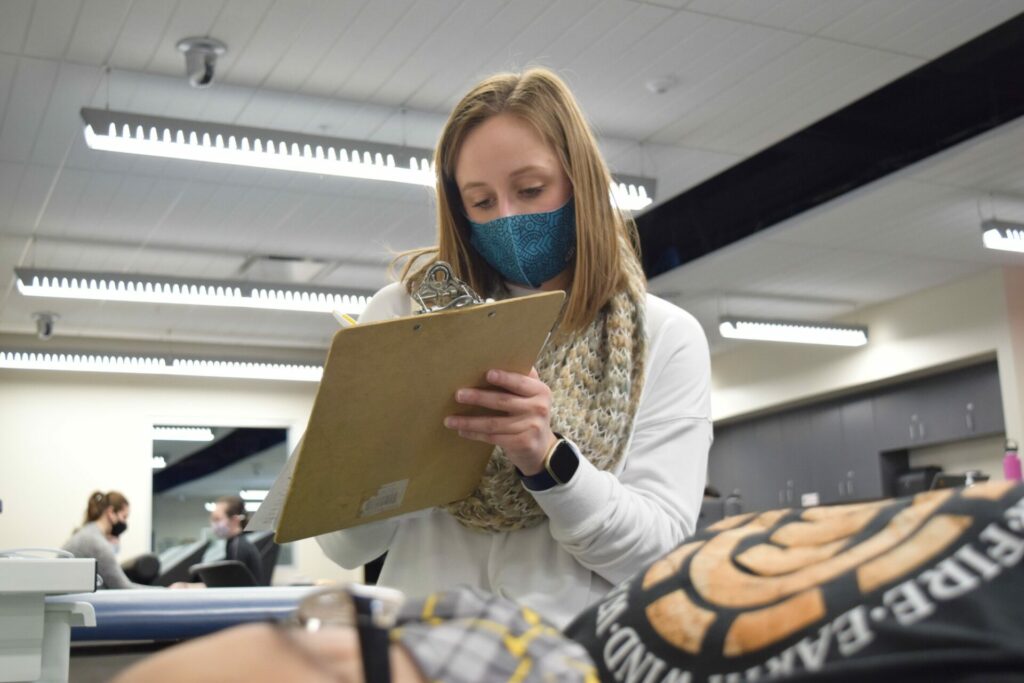One of the benefits of having an athletic trainer on-site for athletic competitions and practices is that they are available to diagnose and treat athletic injuries and illnesses immediately. Often injuries are relatively small, short-lived, and patients can quickly return to their activity. But what about catastrophic injuries? How do athletic trainers prevent and prepare for them?
What is an athletic trainer?
According to the National Athletic Trainer’s Association (NATA), “Athletic trainers (ATs) are highly qualified, multi-skilled health care professionals who render service or treatment, under the direction of or in collaboration with a physician, in accordance with their education, training and the state’s statutes, rules and regulations.” As a part of the health care team, services provided by athletic trainers include primary care, injury and illness prevention, wellness promotion and education, emergent care, examination and clinical diagnosis, therapeutic intervention and rehabilitation of injuries and medical conditions.”
What constitutes a catastrophic sports injury?
The National Center for Catastrophic Sport Injury Research (NCCSIR) classifies catastrophic injuries based on their outcomes: fatality, permanent severe functional disability, and/or severe head or neck trauma with no permanent disability. The NCCSIR created this definition as part of its mission to conduct surveillance of catastrophic injuries and illnesses related to the participation in organized sports in the United States, at all levels from youth to collegiate. By tracking illnesses and injuries in a longitudinal way, they hope to improve the prevention, evaluation, management, and rehabilitation of catastrophic sports-related injuries. The NCCSIR is supported by many organizations, including the NATA.
How do athletic trainers help prevent injuries?
Athletic trainers tackle injury prevention from many different angles. They may educate the populations they serve about wellness, examine equipment, review and practice emergency action plans, prepare medical kits and help shape safety policies and procedures. In an athletic setting they may monitor practices and games and keep an eye out for hazards that may lead to an injury. Sports injury prevention is just as high of a focus for athletic trainers as sports injury treatment. Some things that athletic trainers focus on that prevent catastrophic injuries are:
Protective Equipment
Protective equipment that is used in sports must be manufactured and maintained according to standard guidelines to reduce wear and tear and maximize safety. Athletic trainers are knowledgeable about protective equipment standards and compliance in order to help maintain equipment to protect athletes and prevent injuries.
Acclimatization and Conditioning
According to the NATA, many non-traumatic deaths take place during the first week of activity or a transition period in training. Athletic trainers plan and oversee these transition periods to ensure that acclimatization protocols are implemented and that athletes are kept safe.
Education and Training
Another key area where athletic trainers prevent injuries is through education and training. Aside from training athletes on injury prevention and wellness, athletic trainers can educate other athletic personnel and athletes on preventing and recognizing athletic injuries. One example of this is teaching participants and athletes about the common signs and symptoms of serious injuries so that they can be quickly recognized by themselves and reported for timely evaluation.
How do athletic trainers prepare for injuries and emergencies?
Emergency Action Plans
Emergency action plans can be specific to venues, as well as specific to injuries. For example, many collegiate sports organizations have emergency action plans for head and neck injuries, cardiac arrest, heat illness and stroke, exertional rhabdomyolysis, asthma, and diabetic and mental health emergencies. Athletic trainers help develop these plans, keep them up to date, and implement them in emergency situations.
Prepare emergency equipment
Athletic trainers oversee the acquisition and distribution of medical kits and emergency equipment. For example, athletic trainers ensure that AEDs are located to appropriately minimize the time between a collapse and usage. Athletic trainers regularly check their AEDs to ensure they are fully charged and free of wear and tear. Or in another example, during a practice session with high temperatures, athletic trainers ensure they have a cold tank available for full-body immersion, should an athlete suffer from heat stroke.
When an injury occurs
Although athletic trainers can do a lot to mitigate risks, the activities of athletes are often inherently dangerous, and injuries can occur. Athletic trainers have a role to play here also.
Can athletic trainers diagnose injuries?
The short answer: yes. Athletic trainers know how to diagnose and treat common injuries, including catastrophic injuries. Athletic trainers can quickly assess an injury and decide: can this athlete return to the field of play? Do they need further diagnostics? Can the athletic trainer provide treatment for them here, or do they need to be transported to a medical facility?
Rehabilitation
After a catastrophic injury there can be a long road to recovery and return to normal activity. Athletic trainers are here too, designing rehabilitation plans, helping the patient connect with specialists, and providing ongoing treatment. Just as a catastrophic injury can leave physical scars, they often leave mental scars as well. Athletic trainers help in this arena also, as well as knowing when to refer to a mental health specialist.
Collecting data and reporting
Every athletic injury is a learning opportunity for an athletic trainer. Why did the injury occur? What factors, both obvious and unobvious, played a role? How can the athletic trainer take this data and use it to prevent future injuries? In the case of catastrophic injuries, athletic trainers report the injury to the NCCSIR. NCCSIR asks the same questions on a larger scale, to make participation in athletic activities safer all around.
Conclusion
As you can see, athletic trainers are specialized in helping prevent, recognize, and treat injuries and illnesses in physically active populations. In the case of a catastrophic injury, an athletic trainer can literally change the course of a patient’s life. At the University of Idaho, we believe this oversize responsibility is something that needs to be recognized, and our faculty take care to impart it to our students. Through rigorous athletic training education, we too are striving to make athletic participation safer.
